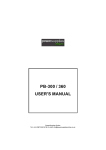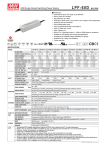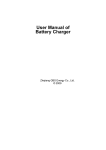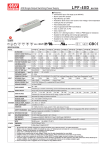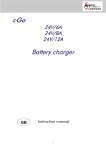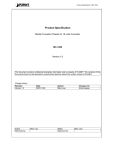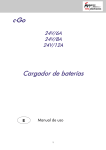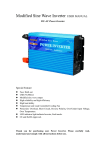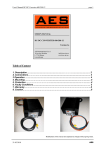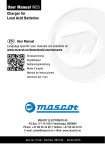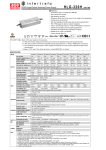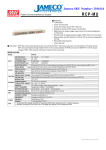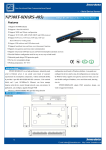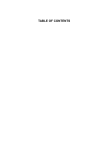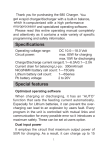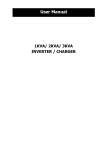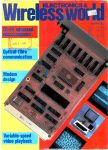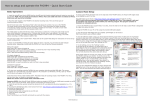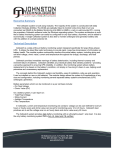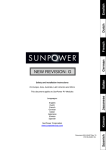Download PB-300 / 360 USER`S MANUAL
Transcript
PB-300 / 360 USER'S MANUAL Sunpower (UK) Ltd Tel: +44 (0)118 981 1001 Fax: +44 (0)118 981 2002 E-mail: [email protected] SPECIFICATION : PB-300 MODEL PB-300P/N-12 PB-300P/N-24 BOOST CHARGE VOLTAGE 14.4V 28.8V FLOAT CHARGE VOLTAGE 13.6V 27.2V VOLTAGE ADJUSTABLE RANGE 13 ~ 14.7V 26 ~ 28.8V RECOMMENDED BATTERY 80 ~ 200Ah OUTPUT CAPACITY(AMP HOURS)(Note 5) 40 ~ 125Ah INPUT BATTERY TYPE Open & Sealed Lead Acid OUTPUT CURRENT(max.) 20.85A 10.5A CONTINUOUS OUTPUT CURRENT (Typ.) (Note 6) 12.5A 6.25A VOLTAGE RANGE 90 ~ 132VAC / 180 ~ 264VAC selected by switch FREQUENCY RANGE 47 ~ 63Hz EFFICIENCY (Typ.) 85% POWER FACTOR (Typ.) >0.65 (with P type) at 230VAC AC CURRENT (Typ.) 6A/115VAC INRUSH CURRENT (Typ.) COLD START 60A LEAKAGE CURRENT <3.5mA / 240VAC 86% 3A/230VAC 90 ~ 110% rated output current OVER LOAD PROTE- REVERSE POLARITY CTION OVER VOLTAGE OVER TEMPERATURE FUNCTION REMOTE CONTROL (CN5) WORKING TEMP. Protection type : Constant current limiting, recovers automatically after fault condition is removed By internal fuse 15 ~ 17V 30 ~ 35V Protection type : Shut down o/p voltage, re-power on to recover Protection type : Automatically derate charge current until zero Open: Normal work -10 ~ +40 Short: Stop Charging (Refer to output load derating curve) 20 ~ 90% RH non-condensing WORKING HUMIDITY ENVIROSTORAGE TEMP., HUMIDITY -40 ~ +85 , 10 ~ 95% RH NMENT TEMP. COEFFICIENT 0.05%/ (0 ~ 45 VIBRATION 10 ~ 500Hz, 2G 10min./1cycle, 60min. each along X, Y, Z axes SAFETY STANDARDS EN60335-2-29 CB Approved by TUV WITHSTAND VOLTAGE I/P-O/P:3KVAC I/P-FG:1.5KVAC O/P-FG:0.5KVAC SAFETY & ISOLATION RESISTANCE I/P-O/P, I/P-FG, O/P-FG:100M Ohms/500VDC EMC (Note 4) EMI CONDUCTION & RADIATION Compliance to EN55022 (CISPR22) Class B HARMONIC CURRENT Compliance to EN61000-4-2,3,4,5,6,8,11; ENV50204, EN55024, Light industry level, criteria A MTBF 115.8Khrs min. OTHERS DIMENSION PACKING NOTE Compliance to EN61000-3-2,-3 (only P type) EMS IMMUNITY MIL-HDBK-217F (25 ) 253*135*48.5mm(L*W*H) 1.45Kg; 6pcs/9.7Kg/0.93CUFT 1. All parameters NOT specially mentioned are measured at 230VAC input, rated load and 25 of ambient temperature. 2. Ripple & noise are measured at 20MHz of bandwidth by using a 12" twisted pair-wire terminated with a 0.1uf & 47uf parallel capacitor. 3. Tolerance : includes set up tolerance, line regulation and load regulation. 4. The power supply is considered a component which will be installed into a final equipment. The final equipment must be re-confirmed that it still meets EMC directives. 5. This is Mean Well's suggested range. Please consult your battery manufacturer for their suggestions about maximum charging current limitation. 6. Test condition is at 25 , charging current will change under different temperature. Sunpower (UK) Ltd Tel: +44 (0)118 981 1001 Fax: +44 (0)118 981 2002 E-mail: [email protected] SPECIFICATION : PB-360 MODEL PB-360P/N-12 PB-360P/N-24 BOOST CHARGE VOLTAGE 14.4V 28.8V FLOAT CHARGE VOLTAGE 13.6V 27.2V VOLTAGE ADJUSTABLE RANGE 13 ~ 14.7V 26 ~ 28.8V OUTPUT RECOMMENDED BATTERY 80 ~ 200Ah CAPACITY(AMP HOURS)(Note 5) 40 ~ 125Ah INPUT BATTERY TYPE Open & Sealed Lead Acid OUTPUT CURRENT(max.) 24.3A VOLTAGE RANGE 90 ~ 132VAC / 180 ~ 264VAC selected by switch FREQUENCY RANGE 47 ~ 63Hz EFFICIENCY (Typ.) 85% POWER FACTOR (Typ.) >0.65 (with P type) at 230VAC AC CURRENT (Typ.) 7A/115VAC INRUSH CURRENT (Typ.) COLD START 60A LEAKAGE CURRENT <3.5mA / 240VAC 12.5A 86% 3.5A/230VAC 90 ~ 110% rated output current OVER LOAD PROTE- REVERSE POLARITY CTION OVER VOLTAGE OVER TEMPERATURE FUNCTION REMOTE CONTROL (CN5) WORKING TEMP. Protection type : Constant current limiting, recovers automatically after fault condition is removed By internal fuse 15 ~ 17V 30 ~ 35V Protection type : Shut down o/p voltage, re-power on to recover Protection type : Automatically derate charge current until zero Open: Normal work -20 ~ +60 Short: Stop Charging (Refer to output load derating curve) 20 ~ 90% RH non-condensing WORKING HUMIDITY ENVIROSTORAGE TEMP., HUMIDITY -40 ~ +85 , 10 ~ 95% RH NMENT TEMP. COEFFICIENT 0.05%/ (0 ~ 45 VIBRATION 10 ~ 500Hz, 2G 10min./1cycle, 60min. each along X, Y, Z axes SAFETY STANDARDS EN60335-2-29 CB Approved by TUV WITHSTAND VOLTAGE I/P-O/P:3KVAC I/P-FG:1.5KVAC O/P-FG:0.5KVAC SAFETY & ISOLATION RESISTANCE I/P-O/P, I/P-FG, O/P-FG:100M Ohms/500VDC EMC (Note 4) EMI CONDUCTION & RADIATION Compliance to EN55022 (CISPR22) Class B HARMONIC CURRENT Compliance to EN61000-4-2,3,4,5,6,8,11; ENV50204, EN55024, Light industry level, criteria A MTBF 115.8Khrs min. OTHERS DIMENSION PACKING NOTE Compliance to EN61000-3-2,-3 (only P type) EMS IMMUNITY MIL-HDBK-217F (25 ) 253*135*48.5mm(L*W*H) 1.5Kg; 6pcs/10Kg/0.93CUFT 1. All parameters NOT specially mentioned are measured at 230VAC input, rated load and 25 of ambient temperature. 2. Ripple & noise are measured at 20MHz of bandwidth by using a 12" twisted pair-wire terminated with a 0.1uf & 47uf parallel capacitor. 3. Tolerance : includes set up tolerance, line regulation and load regulation. 4. The power supply is considered a component which will be installed into a final equipment. The final equipment must be re-confirmed that it still meets EMC directives. 5. This is Mean Well's suggested range. Please consult your battery manufacturer for their suggestions about maximum charging current limitation. Sunpower (UK) Ltd Tel: +44 (0)118 981 1001 Fax: +44 (0)118 981 2002 E-mail: [email protected] ON/OFF SWITCH 230/115VAC SWITCH 230 INLET 3 POLE IEC320 C14 Battery Connection LED +V -V SVR1 DC (+) Warning Please make sure the polarity of the battery is connected correctly! DC (-) Battery 3 Sunpower (UK) Ltd Tel: +44 (0)118 981 1001 Fax: +44 (0)118 981 2002 E-mail: [email protected] Assembly Procedure: 1.Make sure the charger is shut off and choosing suitable wires to connect the charger and batteries based on the rating of charging current. The polarity must be correct: charger output (+) should be connected to the (+) terminal of batteries and charger output (-) should be connected to the (-) terminal. In no times should the (+) and (-) be short together or the charger and batteries will be damaged. 2.Select the correct input voltage range between 115VAC and 230VAC. The selecting switch is preset at 230VAC in the factory. 3.Set the ON/OFF(0/-) power switch to ON(-) and check whether the operation of LED is correct (red : charging; green : battery is full). Notes On Operation: 1.The charger is only suitable for "lead-acid" batteries. 2.The charger should be assembled in the place with good ventilation and low moisture. Exposure to the rain or snow is strictly prohibited. 3.Wires connecting between the charger and batteries should be as short as possible since the high voltage drop on the wires will increase the time required to fully charge the batteries. 4.Make sure the charging voltage and charging current are suitable for the batteries you are using. 5.If the batteries need to connect in series for charging, old batteries are not suggested to be used with new ones or the lifetime of batteries may reduce because of the unbalance charging voltage distribution on new and old batteries. 6.Please turn off the charger before connecting or disconnecting the wires. 7.The charger has a 2-year worldwide warranty, however, damages from misusing the charger will not be included in the coverage of warranty. Status Under General Operation: At the beginning stage of operation, the charger provides the largest current with 14.4Vdc of output voltage (for 12V batteries) to charge batteries. The LED indicator will lighten in red and the built-in fan will spin to dissipate the heat (360W only). After a period of time (probably a couple of hours, based on the capacity of batteries), the charging current will decrease gradually. After reaching 10% of its maximum value, the charger will go into "floating-charge" stage. The fan will stop spinning, charging voltage will decrease to 13.6Vdc, and the LED indicator will turn to green. The relationship between charging current and charging voltage for each operation stage are shown in the curves below: 4 Sunpower (UK) Ltd Tel: +44 (0)118 981 1001 Fax: +44 (0)118 981 2002 E-mail: [email protected] Start V boost V FLT Charge Voltage 100% Charge Current stage 1 stage 3 Constant Current Constant Voltage Floating Red Green LED COLOR State V boost V FLT stage 2 PB-300/360-12 PB-300/360-24 14.4V 28.8V 13.6V 27.2V NOTE: Output voltage of the charger (V FLT ) can be adjusted through SVR1 without connecting the batteries and this adjustment will change the value of V boost at the same time. For example, if originally V FLT is 13.6V and V boost is 14.4V, after adjusting V FLT to 13.2V under no-load condition, V boost will also reduce to 14V. So, please consult the manufacturer of batteries about the suitable charging voltage before make any adjustment. Charging Current And Ambient Temperature 1.The charging current of PB-300 will reduce when the ambient temperature goes up. Please refer to the derating curve shown as below: 100 90 80 LOAD (%) 70 60 40 30 -10 0 10 20 25 30 40 EXTERNAL CASE TEMPERATURE ( 5 50 ) Sunpower (UK) Ltd Tel: +44 (0)118 981 1001 Fax: +44 (0)118 981 2002 E-mail: [email protected] 2.Below the ambient temperature of 40 , PB-360 can provide the maximum charging current to the batteries. If the ambient temperature is higher than 40 , the output current of PB-360 will decrease automatically. Please refer to the derating curve shown as below: 100 90 80 LOAD (%) 70 60 40 30 10 20 30 40 50 AMBIENT TEMPERATURE ( 60 70 ) Selection Of Output Connection: Please choose wires with suitable diameter of its cross section based on the current rating. Please refer to the following table for the information of some frequently used wires. Using red wires to connect the (+) terminals and black ones for (-) terminals is highly recommended. (Black wires for grounding is a usual practice in electrical applications.) Max.Current(A) UL1015(600V 105 ) 35 22 12 8 6 4 2 AWG CROSS SECTION(mm ) 10 12 14 16 18 20 5.262 3.309 2.081 1.309 0.823 0.517 Suggested Battery Capacity: 1.It will not have any problem if the capacity of batteries larger than the suggested value. It just takes more time to make the batteries fully charged! 2.If you have any question about the suitable charging current for the batteries, please refer to the technical data provided by the battery manufacturers or consult the vendor of the batteries. Model Suggested Battery capacity PB-300-12 PB-300-24 PB-360-12 PB-360-24 60-100Ah 30-60Ah 80-200Ah 40-125Ah 6 Sunpower (UK) Ltd Tel: +44 (0)118 981 1001 Fax: +44 (0)118 981 2002 E-mail: [email protected] Notes On Failure Elimination Status No output voltage Possible Reasons Ways to Eliminate Power switch is not set to ON(-) Set the power switch to ON(-) Wrong polarity of the battery connection (output fuse open) Replace the fuse Wrong selection of the 115/230Vac switch Repair required. Please send it back to us or any of our distributors Output voltage Wrong selection of the 115/230Vac is too low switch Can't achieve Batteries are aging or broken the FLOAT (green light) stage after The gauge of output wire is not long period large enough of charging operation Choose the correct input voltage range through the 115/230Vac switch Replace the batteries Choose connecting wires with suitable gauge If you still cannot eliminate the failure situation, please consult MEAN WELL or any of our distributors WARNING : Explosive gases. prevent flames and sparks, Provide adequate ventilation during charging. Disconnect the supply before making or breaking the connections to the battery. Against recharging non-rechargeable batteries. Caution : (1)Temperature of the case will be high during the charging operation. (2)If the AC input terminal does not connect to F.G. or the ground, then the case should be grounded or the leakage current may harm the users while touching the case. (3)The charger should be fixed firmly at its operation place or be mounted on a holding rack for extra support. Reserved space for built in is at least (325*145*55) L*W*H (4)During charging, the battery must be placed in a well ventilated area. 7 Sunpower (UK) Ltd Tel: +44 (0)118 981 1001 Fax: +44 (0)118 981 2002 E-mail: [email protected]








